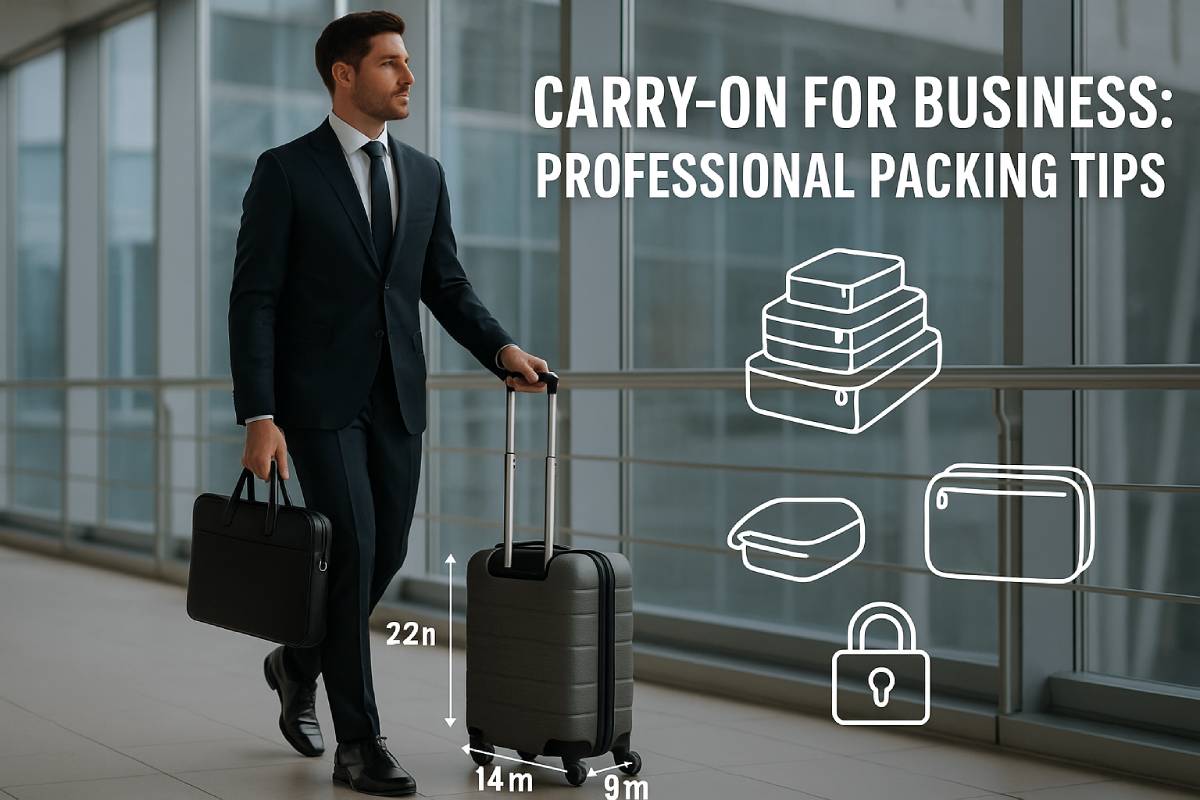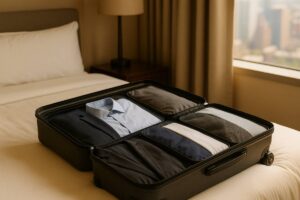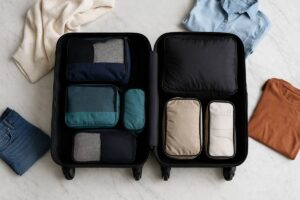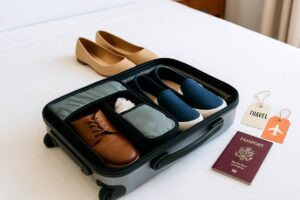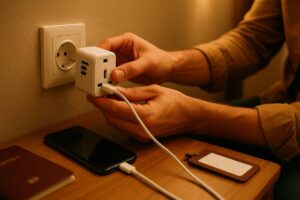Ready to elevate your business travel game? Whether racing between meetings or cruising through an overnight flight, mastering your carry-on is non-negotiable: you need a bag that fits TSA’s 22 × 14 × 9″ overhead-bin rule, protects your gear, and keeps you organized at 30,000 feet.
In this guide, you’ll discover expert-crafted packing systems—from AAA’s universal checklist to rolling and compression tactics—that prevent overpacking and wrinkles.
We’ll cover electronics pouches, TSA’s 3-1-1 liquids protocol, and maintenance rituals that ward off wear and tear. Get ready to pack smarter, stay compliant, and arrive looking sharp.
Below is a breakdown of how to choose the ideal business carry-on, from size compliance to packing smart.
You’ll learn: the precise TSA-approved dimensions (plus airline quirks); the durability trade-offs between hard- and soft-shell shells; must-have organization features like laptop sleeves and packing cubes; mobility considerations for wheels and handles; budget to luxury options; and finally, seasonal/weather resilience and elite-status baggage perks.
Choosing the Right Carry-On Luggage
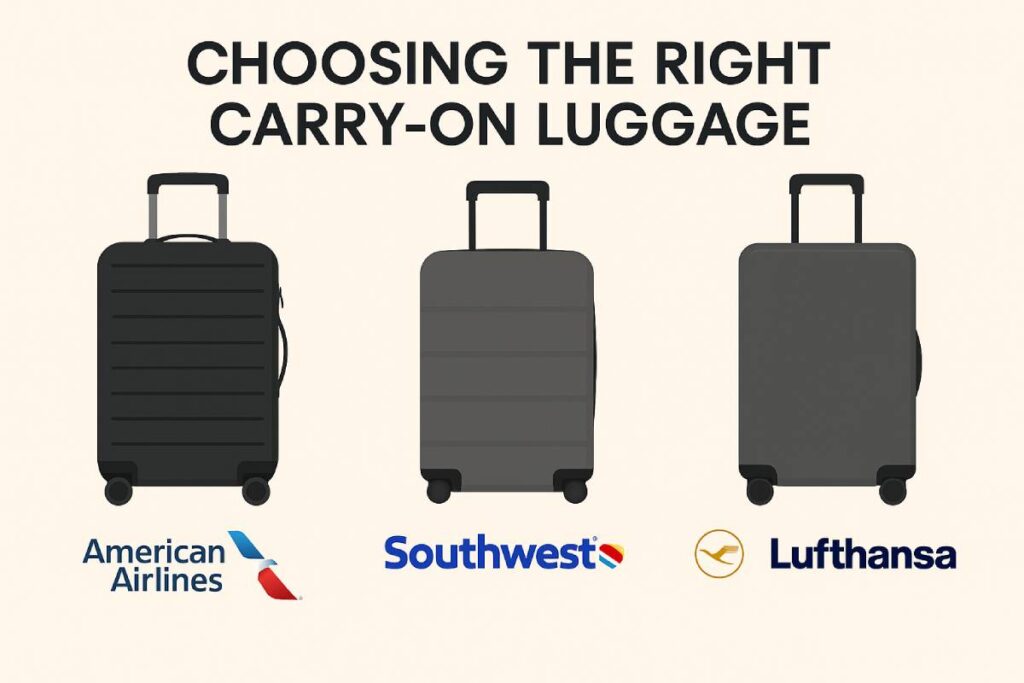
1. TSA-Approved Dimensions & Airline Variations
When you’re rushing to Gate A12, every inch counts—most U.S. carriers cap carry-on size at 22 × 14 × 9 inches (including handles and wheels) to ensure the bag fits in overhead bins. However, Frontier and Southwest relax that to 24 × 16 × 10 inches, giving you a bit more wiggle room if you fly budget domestic.
For international business travel, allowances vary significantly: Garuda Indonesia’s economy limit is just 16 × 13.4 × 6.7 inches, while Hainan Airlines allows 22 × 14.2 × 9.1 inches in business class.
Table: Carry-On Size Allowances by Airline
| Airline | Max Dimensions (in) | Max Weight |
|---|---|---|
| Standard U.S. | 22 × 14 × 9 | N/A |
| Frontier Airlines | 24 × 16 × 10 | 35 lbs |
| Southwest Airlines | 24 × 16 × 10 | N/A |
| Garuda Indonesia | 16 × 13.4 × 6.7 | 15 lbs |
Understanding weight limits by airline is crucial for seamless travel, especially when packing tech equipment and business essentials.
2. Durability & Warranty
Hard-shell cases (polycarbonate or aluminum) excel at shielding electronics and fragile items, while soft-shell variants (nylon or ballistic fabric) weigh less and flex into tight spaces.
Warranty Snapshot:
| Brand | Shell Type | Warranty |
|---|---|---|
| Away Bigger Carry-On | Polycarbonate hard-shell | Limited lifetime warranty |
| Travelpro Platinum Elite | Impact-absorbing polycarbonate | 10-year limited warranty (plus lifetime pilot warranty) |
| All Away suitcases include a limited lifetime guarantee covering functional defects, excluding cosmetic wear. Travelpro offers tiered warranties—from 1-year on Essentials to 10-year and commercial-use coverage—backed by in-house durability testing. |
3. Organization & Tech Compartments
Streamline your workflow on the go with these features:
- Laptop & Document Pockets: Look for laptop-friendly options with padded laptop sleeves and dedicated document pockets, plus RFID-blocking compartments to secure sensitive data. The best business carry-ons feature quick-access laptop compartments that don’t require unpacking your entire bag.
- Packing Cubes & Modular Inserts: Brands like Calpak offer large compression cubes (dual-zipper design) that fit 26+ garments wrinkle-free, while Cadence provides magnetic capsule systems for toiletries (17 – 81 mL).
| Accessory | Key Feature |
|---|---|
| Level8 Business Laptop Bag | Anti-theft, RFID pockets |
| Calpak Compression Cubes | Dual-zip size adjustment |
| Cadence Capsule System | Modular, leak-proof travel containers |
4. Mobility & Maneuverability
- Spinner vs. Inline Wheels: Spinner wheels rotate 360° for effortless turns in terminals, while inline wheels are more robust on uneven surfaces.
- Telescopic Handle Ergonomics: Choose handles with multi-stop height settings and minimal wobble—Travelpro’s PowerScope tech is a good benchmark for comfort and durability.
5. Budget, Mid-Range & Premium Options
| Segment | Model | Price Range |
|---|---|---|
| Budget | Amazon Basics; Quince Small Carry-On | $50–$150 |
| Mid-Range | Travelpro Platinum Elite Hardside Spinner | $200–$300 |
| Premium | Samsonite Proxis Global Carry-On Spinner | $450–$550 |
| Rimowa Essential Lite Cabin | $500–$600 | |
| Budget picks balance cost and basic features; Travelpro’s Platinum Elite blends durability and functionality for avid flyers; and top-end cases like Samsonite Proxis (survived a 130,000 ft drop test) and Rimowa Essential Lite (4.4 lbs, ultra-light) deliver unmatched resilience and style. |
6. Seasonal & Frequency Considerations
- Weather Resistance: Look for water-resistant fabrics and water-repellent zippers to shield gear from rain or snow—many premium cases integrate UV-coated zippers and DWR-treated shells.
- Frequent Flyer Perks: Elite members often get extra baggage allowances and priority boarding: oneworld Emerald/Sapphire flyers receive one additional checked bag up to 23 kg free, while Delta Medallion members enjoy priority boarding and extra checked-bag weight limits of up to 70 lbs per bag.
By factoring in size compliance, ruggedness, organization, mobility, budget tiers, and seasonal or status-based perks, you’ll land the perfect carry-on that keeps your business essentials safe, accessible, and travel-ready.
Professional Packing Tips
Before you pack a single sock, lock in these expert tips: use AAA’s universal checklist to nail the essentials and dodge overpacking; plan a capsule wardrobe by matching outfits to trip length and activities so every piece earns its place.
Leverage Calpak compression cubes and Cadence’s modular capsules to shrink bulk and keep toiletries spill-free; roll garments loosely to save room and prevent creases; stash electronics in labeled pouches and passports in a top-zip compartment for instant access.
Follow the TSA 3-1-1 liquids rule down to the ounce; tuck wallet, boarding pass, and phone in your personal-item’s outer pocket for smooth security lanes; and secure valuables with TSA-recognized locks that keep your bag safe without slowing screening.
1. Create a Comprehensive Packing List
A solid checklist is your best defense against last-minute stress.
- Universal Packing Checklist: Download AAA’s guide covering documents, medications, clothing, toiletries, electronics, and more to ensure you never forget a critical item. Creating your own professional packing checklist tailored to your specific business needs will streamline your packing process and ensure consistency across trips.
- Wardrobe Game Plan: Map outfits to each day’s activities—mix-and-match neutral pieces and plan for laundry to minimize bulk.
2. Maximize Space with Compression & Rolling
Tactics to stretch every cubic inch:
- Compression Cubes: Calpak’s large dual-zipper cubes hold 26+ items wrinkle-free, letting you pack more without the weight of bulky bags.
- Modular Capsules: Cadence’s leak-proof You Capsule and Parcel Set (17–81 mL) keeps liquids organized and spill-free.
- Rolling Technique: Loosely roll shirts and other delicate garments for extra space and minimal creasing.
3. Organizing Electronics & Documents
Keep tech and paperwork at your fingertips:
- Electronics Organizer: Store cords, chargers, and power banks in labeled pouches or a dedicated case to avoid tangles and speed up security checks.
- Document Pocket: Reserve a secure, easily accessible compartment for passports, boarding passes, and business papers, like the exterior pocket of your carry-on.
4. Toiletries & Personal Care
Smooth, spill-free grooming on the go:
- TSA 3-1-1 Rule: All liquids must be in ≤ 3.4 oz (100 mL) containers and fit into one quart-size zipper bag.
Table: TSA 3-1-1 Liquids Rule
| Item | Limit |
|---|---|
| Container size | ≤ 3.4 oz / 100 mL |
| Bag capacity | 1 quart, clear, resealable |
| Quantity per traveler | One bag |
- Leak-Proof Kits: Opt for dopp kits with spill-proof linings or Cadence’s capsule system to keep your toiletries contained.
5. Security & Accessibility
Seamless travel from curb to cabin:
- Quick-Reach Essentials: Tuck your wallet, phone, and boarding pass in the outer pocket of your personal item so you can breeze through checkpoints and boarding.
- TSA-Recognized Locks: Use locks approved by TSA—agents can open them if needed without cutting them off, protecting your bag and speeding inspections.
With these professional packing tips, your carry-on becomes a well-oiled machine: lightweight, organized, compliant, and ready for any business trip. Safe travels!
Maintenance & Care
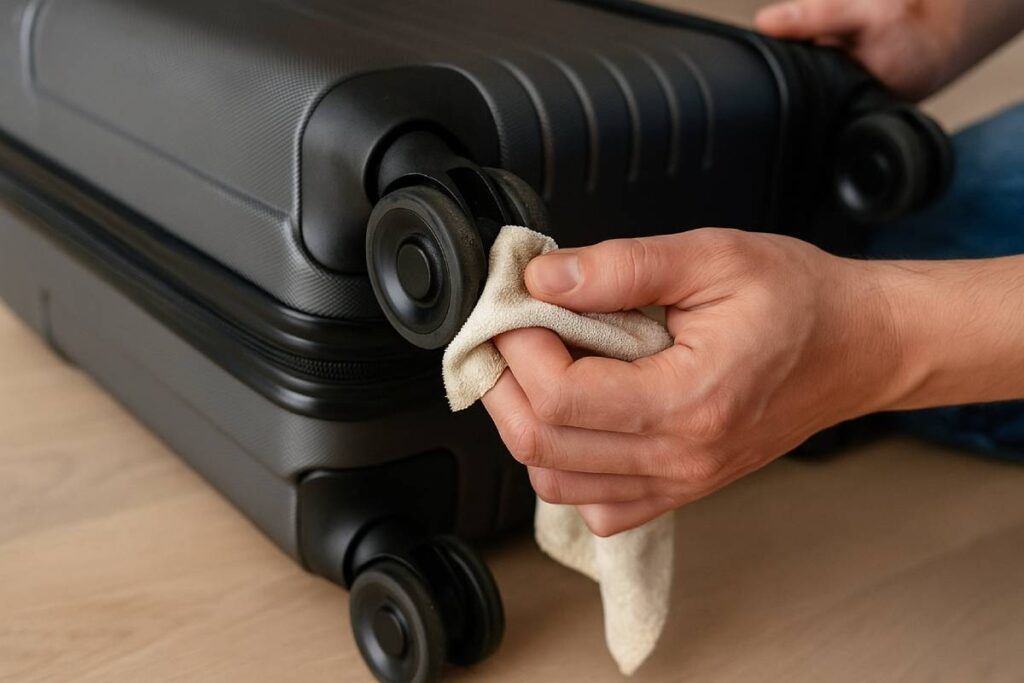
Maintaining your carry-on isn’t just about aesthetics—it’s a core part of ensuring reliability, hygiene, and a professional appearance trip after trip. By regularly cleaning the exterior and wheels, you prevent grime buildup that can degrade materials and impair mobility. Inspecting zippers, seams, and handles before every journey catches small faults before they become catastrophic failures.
Finally, storing your luggage in a cool, dry environment with dust covers and moisture absorbers wards off mold, fading, and structural warping. Together, these simple habits will prolong your bag’s lifespan and keep you traveling in style.
Regularly Clean Exterior and Wheels to Prevent Wear
After each trip, wipe down the exterior of your carry-on with a damp microfiber cloth and mild detergent to lift dirt and grime. For hard-shell cases, a soap-and-water solution applied with a soft sponge restores shine without harming the shell’s integrity. Periodically disinfect handles and latches using sanitizing wipes or a diluted bleach solution (½ cup bleach per gallon of water) to kill lingering bacteria.
Wheels are the workhorses of your bag—brush out embedded debris with a soft toothbrush, then wipe spinning parts with a damp cloth to prevent blockages and premature wear.
Table 1: Cleaning Tools & Suggested Frequency
| Task | Tool | Frequency |
|---|---|---|
| Exterior wipe-down | Microfiber cloth + mild soap | After every trip |
| Hard-shell polishing | Soft sponge + soap-water solution | Monthly |
| Disinfect handles/latches | Sanitizing wipes/bleach solution | Bi-weekly |
| Wheel debris removal | Soft toothbrush + damp cloth | Monthly or as needed |
Inspect Zippers, Seams, and Handles Before Each Trip
Before you pack, run your fingers along every zipper to feel for stiff spots or snagging—these are early signs of wear that can lead to failure mid-trip. Use an old toothbrush to gently dislodge dirt in the teeth, then glide a bit of candle wax or specialized zipper lubricant along the track to keep sliders moving smoothly.
Examine all seams and stitching for loose threads or fabric gaps. Reinforce any weak points with a quick hand-stitch or a dab of fabric sealant to stop small snags from becoming tears.
Test the telescopic handle by extending and retracting it several times—listen for wobble and check for stiffness. Tighten loose screws (usually Philips or Hex) with the right driver to restore structural stability.
Store in Cool, Dry Place and Use Dust Covers to Prolong Lifespan
Humidity is luggage’s worst enemy: store your carry-on in a well-ventilated, climate-controlled closet rather than a damp basement or sweltering attic to prevent mold and mildew growth. Slip a breathable dust cover over your suitcase—this keeps dust and UV light off painted or polycarbonate shells, preserving color and finish.
Tuck a few silica gel packets into interior pockets or cavities to absorb residual moisture and ward off musty odors. If you own multiple bags, nest smaller cases inside larger ones—this saves space and provides mutual support that reduces warping over time. Finally, after cleaning, air out your luggage (open with zippers unzipped) for at least 24 hours so any trapped moisture evaporates fully before storage.
By integrating these maintenance rituals—thorough cleanings, pre-trip inspections, and mindful storage—you’ll keep your carry-on in peak condition, ensuring it remains a reliable and professional travel companion for years to come.
Conclusion
As business travelers, our carry-on is more than just a bag—it’s your mobile office, wardrobe, and security-checkpoint pass all in one. By adhering strictly to TSA’s 22 × 14 × 9″ guideline, you eliminate the risk of unexpected gate-check fees and lost time. Implementing compression cubes and rolling techniques not only gives you more space but also preserves your professional wardrobe wrinkle-free.
Labeling electronics in dedicated pouches and storing passports in a zippered front pocket streamlines security screening and keeps critical documents secure. Observing the 3-1-1 liquids rule means fewer hold-ups at TSA checkpoints—pack toiletries in clear, quart-size bags to breeze through without surprises. Selecting a carry-on with smooth spinner wheels and sturdy telescopic handles reduces airport fatigue and accelerates your transit from gate to meeting.
Finally, regular maintenance—wiping down exteriors, cleaning wheels, lubricating zippers, and storing in a dust cover—prolongs your luggage’s life and keeps it looking polished. Whether you choose a budget-friendly Amazon Basics spinner or a premium Rimowa Essential, these best practices ensure your carry-on performs flawlessly trip after trip. Embrace these steps, and your next business journey will be smoother, more organized, and undeniably professional.
FAQs
What are the TSA carry-on size limits?
The standard U.S. carry-on size is 22 × 14 × 9 inches (handles/wheels included); some airlines like Frontier and Southwest allow up to 24 × 16 × 10 inches.
How can compression cubes improve packing?
Compression cubes can boost your suitcase capacity by up to 30%, keeping garments wrinkle-free and easy to organize.
What is the TSA 3-1-1 liquids rule?
All liquids, gels, and aerosols must be in ≤ 3.4 oz (100 mL) containers, fitting in one quart-size clear bag per passenger.
How do I maintain my carry-on?
Wipe exteriors after every trip, brush debris from wheels monthly, lubricate zippers with wax, and store in a cool, dry spot under a breathable dust cover.
Which carry-on brands are best for business travel?
Top picks include Travelpro Platinum Elite for durability, Samsonite Proxis for premium resilience, and Amazon Basics Spinner for budget reliability

